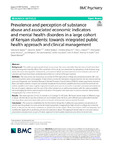Prevalence and perception of substance abuse and associated economic indicators and mental health disorders in a large cohort of Kenyan students: towards integrated public health approach and clinical management

View/
Date
2022Author
Mutiso, Victoria N.
Ndetei, David M.
Muia, Esther N.
Musyimi, Christine
Osborn, Tom L.
Metadata
Show full item recordAbstract
Background: The earlier younger people begin to use drugs, the more vulnerable they become to both their short
term and long-term harmful efects. The overall aim of this study is to determine the prevalence of alcohol and drug
abuse, the socio-demographic characteristic, perception of abuse and associated economic indicators and mental
disorders and how they inform potential intervention in a cohort of Kenyan students.
Methods: This was a cross-sectional study on a total of 9742 high school, college and university students. We used
tools to document socio-demographic characteristics, economic indicators, drug and alcohol use and related perceptions and Diagnostic and Statistical Manual of Mental Disorders, Fourth Edition (DSM-IV) related psychiatric disorders.
Basic descriptive statistics (means and standard deviations for numerical variables and frequencies for nominal and
ordinal variables) were done. Logistic regression models were used to assess the association and odds ratios between
the use of a given substance and the use of the other substances, as well as associations with the various available
socio-demographic factors and economic indicators. Chi-squared tests were used in socio-economic characteristics
disaggregated by current alcohol use.
Results: The mean age was 21.4±2.4; median=21.3 (range 15–43) years. We found a wide range of diferent drugs
of abuse. Alcohol abuse was the commonest and inhalants were the least, with diferent perceptions.Both alcohol
and drug abuse were associated with various economic indicators and various mental disorders.
Conclusion: This study has established for the frst time in Kenya the multifaceted associations and predictors of
alcohol and drug abuse in a cross-sectional student population ranging from high school to college and university
levels. In the process, the study contributes to global data on the subject. These associations call for an integrated and
multifaceted approach in addressing alcohol and substance abuse. This approach should take into account various
associations and predictors as part of holistic approach in both public awareness and clinical interventions
